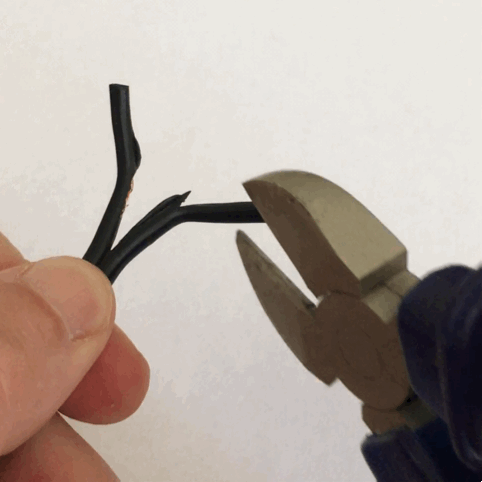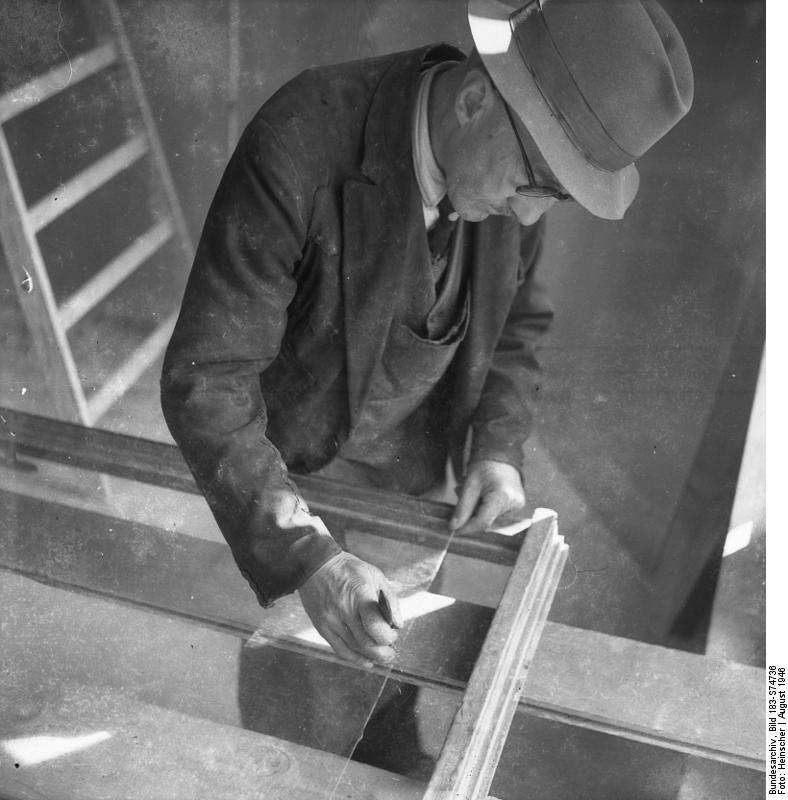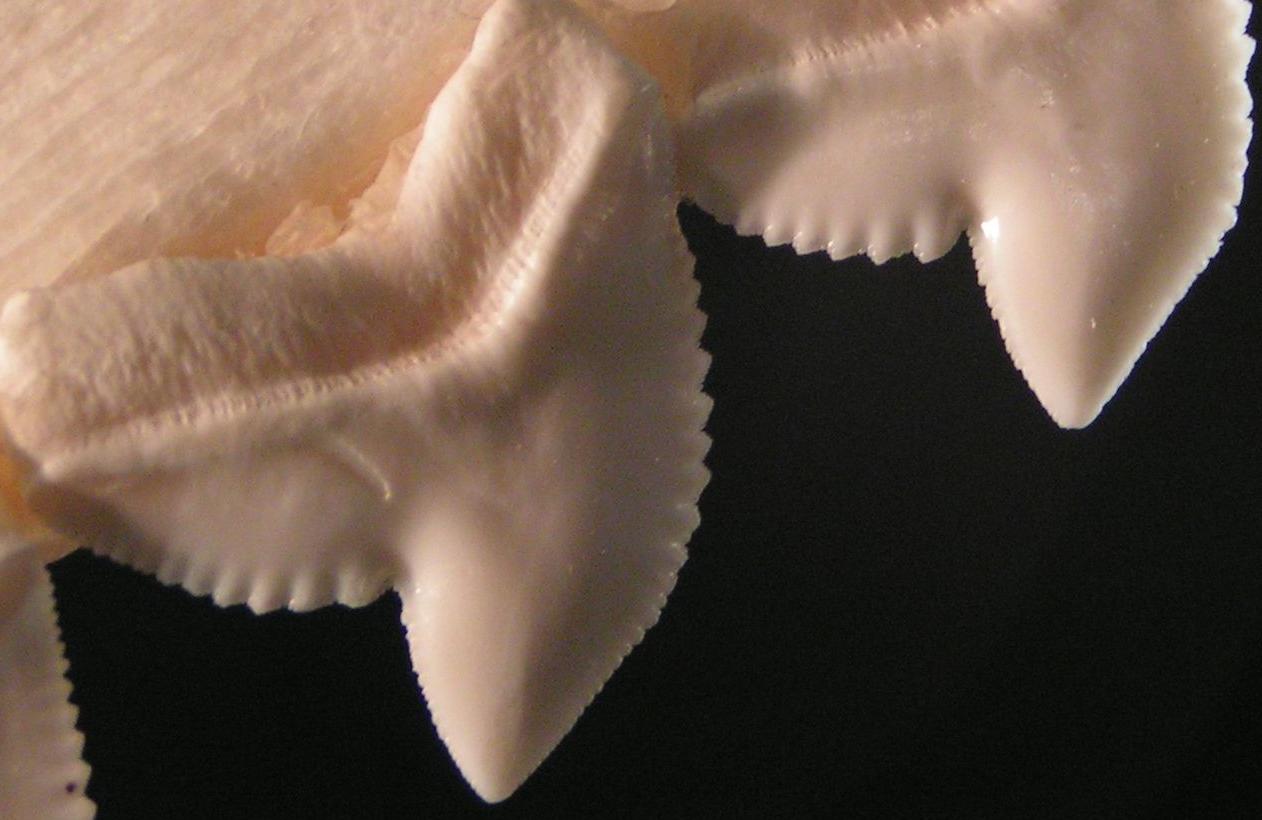|
Breaker-grozier Pliers
Breaker-grozier pliers, or groziers, are pliers used by glaziers to break and finish glass in a controlled manner, a technique known as grozing. They are dual purpose pliers, with a flat jaw that is used for breaking out scores and a curved jaw that is used for grozing flares from the edge of broken glass. Both jaws are serrated for removing flares and tiny points of glass. Use To break out a score, the glass to be removed is held firmly in the pliers, with the flat jaw on top of the glass near the score line. A sharp bend downward breaks the glass at the score. To remove unwanted glass flares and unwanted points, the glass piece is held with one hand with the pliers curved side up. A gentle upward rolling scrapes the glass edge against the serrated teeth and removes unwanted glass flares. This removal process is known as grozing. The tips of these pliers can also be used in a chewing motion to remove small sections of glass or nibble out deep inside curves. Other tools Glazier ... [...More Info...] [...Related Items...] OR: [Wikipedia] [Google] [Baidu] |
Pliers
Pliers are a hand tool used to hold objects firmly, possibly developed from tongs used to handle hot metal in Bronze Age Europe. They are also useful for bending and physically compressing a wide range of materials. Generally, pliers consist of a pair of metal first-class levers joined at a fulcrum positioned closer to one end of the levers, creating short ''jaws'' on one side of the fulcrum, and longer handles on the other side. This arrangement creates a mechanical advantage, allowing the force of the grip strength to be amplified and focused on an object with precision. The jaws can also be used to manipulate objects too small or unwieldy to be manipulated with the fingers. Diagonal pliers, also called side cutters, are a similarly-shaped tool used for cutting rather than holding, having a pair of stout blades, similar to scissors except that the cutting surfaces meet parallel to each other rather than overlapping. Ordinary (holding/squeezing) pliers may incorporate a s ... [...More Info...] [...Related Items...] OR: [Wikipedia] [Google] [Baidu] |
Glazier
A glazier is a tradesman responsible for cutting, installing, and removing glass (and materials used as substitutes for glass, such as some plastics).Elizabeth H. Oakes, ''Ferguson Career Resource Guide to Apprenticeship Programs'' ( Infobase: 3d ed., 2006), p. 356. They also refer to blueprints to figure out the size, shape, and location of the glass in the building. They may have to consider the type and size of scaffolding they need to stand on to fit and install the glass. Glaziers may work with glass in various surfaces and settings, such as cutting and installing windows, doors, shower doors, skylights, storefronts, display cases, mirrors, facades, interior walls, ceilings, and tabletops.Glaziers (profile in the |
Serrate
Serration is a saw-like appearance or a row of sharp or tooth-like projections. A serrated cutting edge has many small points of contact with the material being cut. By having less contact area than a smooth blade or other edge, the applied pressure at each point of contact is greater and the points of contact are at a sharper angle to the material being cut. This causes a cutting action that involves many small splits in the surface of the material being cut, which cumulatively serve to cut the material along the line of the blade. In nature, serration is commonly seen in the cutting edge on the teeth of some species, usually sharks. However, it also appears on non-cutting surfaces, for example in botany where a toothed leaf margin or other plant part, such as the edge of a carnation petal, is described as being serrated. A serrated leaf edge may reduce the force of wind and other natural elements. Probably the largest serrations on Earth occur on the skylines of mountains (th ... [...More Info...] [...Related Items...] OR: [Wikipedia] [Google] [Baidu] |
Architectural Glass
Architectural glass is glass that is used as a building material. It is most typically used as transparent glazing material in the building envelope, including windows in the external walls. Glass is also used for internal partitions and as an architectural feature. When used in buildings, glass is often of a safety type, which include reinforced, toughened and laminated glasses. History Timeline of modern architectural glass development * 1226: "Broad Sheet" first produced in Sussex. * 1330: " Crown glass" for art work and vessels first produced in Rouen, France. "Broad Sheet" also produced. Both were also supplied for export. * 1500s: A method of making mirrors out of plate glass was developed by Venetian glassmakers on the island of Murano, who covered the back of the glass with a mercury-tin amalgam, obtaining near-perfect and undistorted reflection. * 1620s: "Blown plate" first produced in London. Used for mirrors and coach plates. * 1678: " Crown glass" first produced in L ... [...More Info...] [...Related Items...] OR: [Wikipedia] [Google] [Baidu] |
Beveled Glass
Beveled glass is usually made by taking thick glass and creating an angled surface cut ( bevel) around the entire periphery. Bevels act as prisms in sunlight creating an interesting color refraction which both highlights the glass work and provides a spectrum of colors which would ordinarily be absent in clear float glass. Beveled glass can be obtained as clusters which are arranged to create a specific design. These can vary from simple three or four piece designs, often used in top lights (commonly known as transoms) of windows and conservatories, to more complex combinations of many pieces, suitable for larger panels such as doors and side screens (known in the door industry as sidelites). Beveled glass has also been used with clear and colored textured glass to create designs. Textured glass is typically thick and has a distinct visible texture. Beveled glass is typical made from float plate glass but thicknesses up to have been used for larger windows. The width ... [...More Info...] [...Related Items...] OR: [Wikipedia] [Google] [Baidu] |
Came Glasswork
Came glasswork is the process of joining cut pieces of art glass through the use of came strips or foil into picturesque designs in a framework of soldered metal. Final products include a wide range of glasswork, including stained glass and leadlight, lead light pieces. Came is made of different metals, such as lead, zinc, brass and copper. The metal came selected generally depends upon the size, complexity and weight of the project. As an alternative to came, copper foil may be used, for small, intricate pieces. Overview Came glasswork includes assembling pieces of cut and possibly painted Art glass, glass using came sections. The joints where the came meet are soldered to bind the sections. When all of the glass pieces have been put within came and a border put around the entire work, pieces are cemented and supported as needed. The work may be made waterproof by forcing a soft oily cement or Putty, mastic between the glass and the cames. A form of embellishment and gilding, ... [...More Info...] [...Related Items...] OR: [Wikipedia] [Google] [Baidu] |
Cathedral Glass
Cathedral glass is the name given commercially to monochromatic sheet glass. It is thin by comparison with ''slab glass'', may be coloured, and is textured on one side. The name draws from the fact that windows of stained glass were a feature of medieval European cathedrals from the 10th century onwards. The term ''cathedral glass'' is sometimes applied erroneously to the windows of cathedrals as an alternative to the term ''stained glass''. Stained glass is the material and the art form of making coloured windows of elaborate or pictorial design. Manufacture Traditional methods of making coloured glass Very early architectural glass, like that sometimes found in excavations of Roman baths, was cast. The molten glass was poured into a mold of wood or stone to make a sheet of glass. The texture of the mold material would be picked up by the glass. By the time stained glass was being made, the glassblowing pipe was in common use, so hand-blown (or mouth-blown) sheets were made ... [...More Info...] [...Related Items...] OR: [Wikipedia] [Google] [Baidu] |
Fracture Glass
Tiffany glass refers to the many and varied types of glass developed and produced from 1878 to 1933 at the Tiffany Studios in New York City, by Louis Comfort Tiffany and a team of other designers, including Clara Driscoll, Agnes F. Northrop, and Frederick Wilson. In 1865, Tiffany traveled to Europe, and in London he visited the Victoria and Albert Museum, whose extensive collection of Roman and Syrian glass made a deep impression on him. He admired the coloration of medieval glass and was convinced that the quality of contemporary glass could be improved upon. In his own words, the "Rich tones are due in part to the use of pot metal full of impurities, and in part to the uneven thickness of the glass, but still more because the glass maker of that day abstained from the use of paint". Tiffany was an interior designer, and in 1878 his interest turned toward the creation of stained glass, when he opened his own studio and glass foundry because he was unable to find the types of ... [...More Info...] [...Related Items...] OR: [Wikipedia] [Google] [Baidu] |
Fracture-streamer Glass
Tiffany glass refers to the many and varied types of glass developed and produced from 1878 to 1933 at the Tiffany Studios in New York City, by Louis Comfort Tiffany and a team of other designers, including Clara Driscoll, Agnes F. Northrop, and Frederick Wilson. In 1865, Tiffany traveled to Europe, and in London he visited the Victoria and Albert Museum, whose extensive collection of Roman and Syrian glass made a deep impression on him. He admired the coloration of medieval glass and was convinced that the quality of contemporary glass could be improved upon. In his own words, the "Rich tones are due in part to the use of pot metal full of impurities, and in part to the uneven thickness of the glass, but still more because the glass maker of that day abstained from the use of paint". Tiffany was an interior designer, and in 1878 his interest turned toward the creation of stained glass, when he opened his own studio and glass foundry because he was unable to find the types of ... [...More Info...] [...Related Items...] OR: [Wikipedia] [Google] [Baidu] |
Ring Mottle Glass
Tiffany glass refers to the many and varied types of glass developed and produced from 1878 to 1933 at the Tiffany Studios in New York City, by Louis Comfort Tiffany and a team of other designers, including Clara Driscoll, Agnes F. Northrop, and Frederick Wilson. In 1865, Tiffany traveled to Europe, and in London he visited the Victoria and Albert Museum, whose extensive collection of Roman and Syrian glass made a deep impression on him. He admired the coloration of medieval glass and was convinced that the quality of contemporary glass could be improved upon. In his own words, the "Rich tones are due in part to the use of pot metal full of impurities, and in part to the uneven thickness of the glass, but still more because the glass maker of that day abstained from the use of paint". Tiffany was an interior designer, and in 1878 his interest turned toward the creation of stained glass, when he opened his own studio and glass foundry because he was unable to find the types of ... [...More Info...] [...Related Items...] OR: [Wikipedia] [Google] [Baidu] |
Rippled Glass
Rippled glass refers to textured glass with marked surface waves. Louis Comfort Tiffany made use of such textured glass to represent, for example, water or leaf veins. The texture is created during the glass sheet-forming process. A sheet is formed from molten glass with a roller that spins on itself, while travelling forward. Normally the roller spins at the same speed as its own forward motion, and the resulting sheet has a smooth surface. In the manufacture of rippled glass, the roller spins faster than its own forward motion. The rippled effect is retained as the glass cools. In order to cut rippled glass, the sheet may be scored on the smoother side with a carbide glass cutter, and broken at the score line with breaker-grozier pliers. See also * Architectural glass * Beveled glass * Came glasswork * Cathedral glass * Drapery glass * Fracture glass * Fracture-streamer glass * Ring mottle glass * Stained glass * Streamer glass Tiffany glass refers to the many and varie ... [...More Info...] [...Related Items...] OR: [Wikipedia] [Google] [Baidu] |




.jpg)



